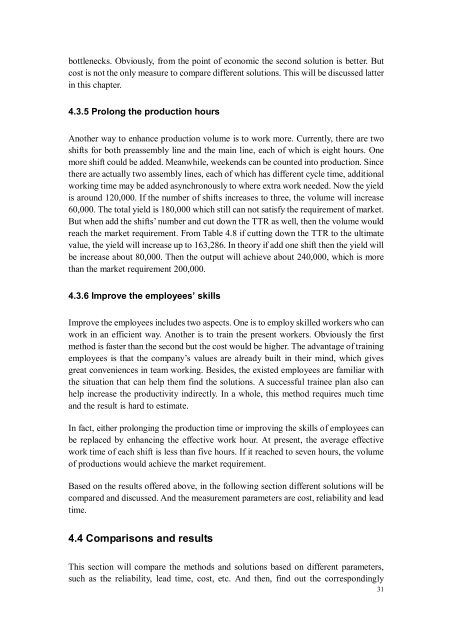Improvement of Material Flow in the Production and Supply Chain of ...
Improvement of Material Flow in the Production and Supply Chain of ...
Improvement of Material Flow in the Production and Supply Chain of ...
You also want an ePaper? Increase the reach of your titles
YUMPU automatically turns print PDFs into web optimized ePapers that Google loves.
ottlenecks. Obviously, from <strong>the</strong> po<strong>in</strong>t <strong>of</strong> economic <strong>the</strong> second solution is better. But<br />
cost is not <strong>the</strong> only measure to compare different solutions. This will be discussed latter<br />
<strong>in</strong> this chapter.<br />
4.3.5 Prolong <strong>the</strong> production hours<br />
Ano<strong>the</strong>r way to enhance production volume is to work more. Currently, <strong>the</strong>re are two<br />
shifts for both preassembly l<strong>in</strong>e <strong>and</strong> <strong>the</strong> ma<strong>in</strong> l<strong>in</strong>e, each <strong>of</strong> which is eight hours. One<br />
more shift could be added. Meanwhile, weekends can be counted <strong>in</strong>to production. S<strong>in</strong>ce<br />
<strong>the</strong>re are actually two assembly l<strong>in</strong>es, each <strong>of</strong> which has different cycle time, additional<br />
work<strong>in</strong>g time may be added asynchronously to where extra work needed. Now <strong>the</strong> yield<br />
is around 120,000. If <strong>the</strong> number <strong>of</strong> shifts <strong>in</strong>creases to three, <strong>the</strong> volume will <strong>in</strong>crease<br />
60,000. The total yield is 180,000 which still can not satisfy <strong>the</strong> requirement <strong>of</strong> market.<br />
But when add <strong>the</strong> shifts’ number <strong>and</strong> cut down <strong>the</strong> TTR as well, <strong>the</strong>n <strong>the</strong> volume would<br />
reach <strong>the</strong> market requirement. From Table 4.8 if cutt<strong>in</strong>g down <strong>the</strong> TTR to <strong>the</strong> ultimate<br />
value, <strong>the</strong> yield will <strong>in</strong>crease up to 163,286. In <strong>the</strong>ory if add one shift <strong>the</strong>n <strong>the</strong> yield will<br />
be <strong>in</strong>crease about 80,000. Then <strong>the</strong> output will achieve about 240,000, which is more<br />
than <strong>the</strong> market requirement 200,000.<br />
4.3.6 Improve <strong>the</strong> employees’ skills<br />
Improve <strong>the</strong> employees <strong>in</strong>cludes two aspects. One is to employ skilled workers who can<br />
work <strong>in</strong> an efficient way. Ano<strong>the</strong>r is to tra<strong>in</strong> <strong>the</strong> present workers. Obviously <strong>the</strong> first<br />
method is faster than <strong>the</strong> second but <strong>the</strong> cost would be higher. The advantage <strong>of</strong> tra<strong>in</strong><strong>in</strong>g<br />
employees is that <strong>the</strong> company’s values are already built <strong>in</strong> <strong>the</strong>ir m<strong>in</strong>d, which gives<br />
great conveniences <strong>in</strong> team work<strong>in</strong>g. Besides, <strong>the</strong> existed employees are familiar with<br />
<strong>the</strong> situation that can help <strong>the</strong>m f<strong>in</strong>d <strong>the</strong> solutions. A successful tra<strong>in</strong>ee plan also can<br />
help <strong>in</strong>crease <strong>the</strong> productivity <strong>in</strong>directly. In a whole, this method requires much time<br />
<strong>and</strong> <strong>the</strong> result is hard to estimate.<br />
In fact, ei<strong>the</strong>r prolong<strong>in</strong>g <strong>the</strong> production time or improv<strong>in</strong>g <strong>the</strong> skills <strong>of</strong> employees can<br />
be replaced by enhanc<strong>in</strong>g <strong>the</strong> effective work hour. At present, <strong>the</strong> average effective<br />
work time <strong>of</strong> each shift is less than five hours. If it reached to seven hours, <strong>the</strong> volume<br />
<strong>of</strong> productions would achieve <strong>the</strong> market requirement.<br />
Based on <strong>the</strong> results <strong>of</strong>fered above, <strong>in</strong> <strong>the</strong> follow<strong>in</strong>g section different solutions will be<br />
compared <strong>and</strong> discussed. And <strong>the</strong> measurement parameters are cost, reliability <strong>and</strong> lead<br />
time.<br />
4.4 Comparisons <strong>and</strong> results<br />
This section will compare <strong>the</strong> methods <strong>and</strong> solutions based on different parameters,<br />
such as <strong>the</strong> reliability, lead time, cost, etc. And <strong>the</strong>n, f<strong>in</strong>d out <strong>the</strong> correspond<strong>in</strong>gly<br />
31

















